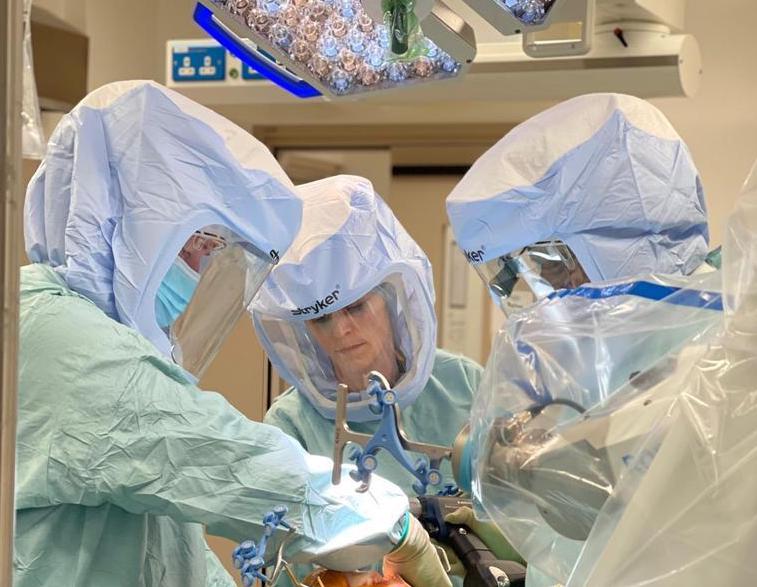Pic credit; Shutterstock
The fundamental question mosts patients will ask is;
At what point do I seriously consider knee replacement surgery to be the best option?
Knee replacement surgery specialists explain when the timing may be right to consider total knee replacement. Decision making has to be based on an assessment of the following:
- individual anatomical differences,
- accurate and advanced diagnostics,
- consideration of the patient's own needs and
- the range of symptoms that are being experienced.
If you are considering knee replacement surgery as well as other treatment approaches, factors such as timing will be important and a number of questions should be asked and answered satisfactorily first. It is also worthwhile reading different surgical approahes for getting excellent results in knee replacement surgery. Some of the question you may wish to ask include the following:
- What are the typical signs that knee replacement surgery may be required?
- Why do the symptoms of knee degeneration vary so much?
- Should surgery always be considered as a last resort ?
- Can you leave surgery for an osteoarthritic knee too late?
The decision to operate and perform a knee replacement is a shared process, and a careful conversation needs to occur regarding the timing, method, procedure, risks and benefits.
What are the typical signs that knee replacement surgery may be required?
When your knees wear out..
Knee replacement surgery is usually required when the surface of the knee has worn out, with a loss of surface articular cartilage exposing the underlying bone and nerve endings. This process is called osteoarthritis. Osteoarthritis can be primary osteoarthritis or secondary osteoarthritis (ie secondary to some other process which could be inflammatory arthritis, trauma, infection and other causes).
Depending on which part of the knee is affected, this condition can cause a combination of pain, instability, deformity and loss of function.
In the majority of cases of osteoarthritic knee there is loss of the medial surface of the knee, which often leads to a bow legged (varus) deformity. Typically this results in pain on walking.
The alternative form of osteoarthritis is the outer compartmental wear pattern (ie the valgus deformity). This often results in the giving way of the knee and the feeling of instability. This pattern is slightly more challenging because pain is usually only a late feature, it is frequently diagnosed when it has already progressed.
Advanced imaging to diagnose if knee replacement needed
It is often also a disease of the flexor surface of the outer joint, and therefore under-estimated by standard X-rays of the knee. Knee surgeons therefore will often get some more thorough X-rays which include a Rosenberg (Schuss) view along with a Skyline view of the patella as this will often unmask the lateral osteoarthritic pattern in the knee. The X-rays should involve a series of comprehensive X-rays taken from four views - including the following:
- AP weightbearing,
- lateral,
- skyline and
- Rosenberg
A small proportion of cases will involve isolated patello-femoral arthritis. This is where the wear pattern is at the front of the knee, between the patella and the trochlear groove.
This typically leads to pain on walking up and down stairs and inclines. Instability may be an issue, but walking on the flat is often quite comfortable. In many cases there will be combined patterns of osteoarthritis of the knee. It is therefore important for an accurate diagnosis to be made, and appropriate advice and treatment plan formulated depending on their unique symptoms, deformity and lack of function.
Why do the symptoms of knee degeneration vary so much?
 The symptoms caused when the surface of the knee wears out vary tremendously. Sometimes there will be pain caused by exposure of the underlying bone as the cartilage surface of the knee disintegrates and wears out.
The symptoms caused when the surface of the knee wears out vary tremendously. Sometimes there will be pain caused by exposure of the underlying bone as the cartilage surface of the knee disintegrates and wears out.
Sometimes there is instability within the knee, when the lack of cartilage and exposed bone and subsequent loss of joint surface then leads to deformity and ligamentous laxity (particularly in the knock knee deformity).
Missing shock absorber
As the surface of the knee wears out, the shock absorber cartilage (ie the meniscus), can also be ground away and ejected from the joint (called a degenerate meniscal tear with meniscal extrusion). This can lead to some pain from the unstable degenerate edge of the meniscus, and also pain from the soft tissue envelope that is stretched over the ejected and degenerate meniscus.
Synovial fluid pouch
Occasionally the disintegrating surface can form cartilage of bony loose bodies which can then jam the joint and cause sharp pains within the knee, as well as locking. The synovial lining of the joint often creates synovial fluid to compensate for the degenerating knee, and this can pouch in various areas of the knee (most often causing a Baker’s cyst and pain at the back of the knee), all of which add to the pain. Occasionally the Baker’s cyst ruptures and causes pain in the calf with swelling in the ankle.
Given the tremendous variation in the degenerative process, it is understandable that all of the above issues will cause greater or lesser amounts of pain and discomfort in the knee and this will vary from person to person.
Frequently, in the early stages of osteoarthritis, the symptoms may be occasional, but they become more frequent and severe in intensity as the deformity progresses.
Should surgery always be considered as a last resort ?
The process of degeneration in the knee actually represents a progressive degeneration of the surface tissue. It is generally accepted that an osteoarthritic knee may be helped with a number of initial treatments. These treatments may include the following:
- weight loss,
- muscle strengthening,
- physiotherapy (to maintain range of motion and muscle tone in the leg),
- injection therapies (which includes steroid injections, visco supplementation and stem cell type procedures), and
- partial and total knee replacement surgery.
- Bracing may also help during activity prior to joint replacement surgery.
It is also generally accepted that a knee replacement is more likely to be successful in individuals whose pre-operative range of motion remains good and muscle tone is maintained. Knee replacement surgery should therefore be considered on a case by case basis and forms part of the therapeutic options that are available to cure this condition.
Can you leave surgery for an osteoarthritic knee too late?
The decision on whether to intervene with surgery for an osteoarthritic knee is a complex one. It is important to consider carefully and go through the symptoms, clinical examination and radiological imaging.
The best knee replacement results are done on a knee that has a tremendous range of motion in it. Having strong muscles also helps the rehabilitative process so it is often wise not to leave the situation until severe deformity, stiffness and loss of function have set in over the years. Each case is different and each presentation is unique. Often individiduals will have tried conservative treatments and have come to the realisation that although these may have helped for a short period of time, they have not provided the cure.
If the right moment is chosen, where the patients' quality of life is deteriorating based on the progression of their osteoarthritic knee, a knee replacement should positively transform their lives.
Ligamentous incompetence
Occasionally I see someone who has been suffering from progressive severe deformity in their knee. Once ligamentous incompetence and stiffness become established in the knee, the surgical outcome may be compromised. This is because modern knee replacements are surface replacements, relying on the normally functioning ligaments around the knee. If ligamentous incompetence has occurred, more advanced and invasive replacements, which have to compensate for this may have to take place.









